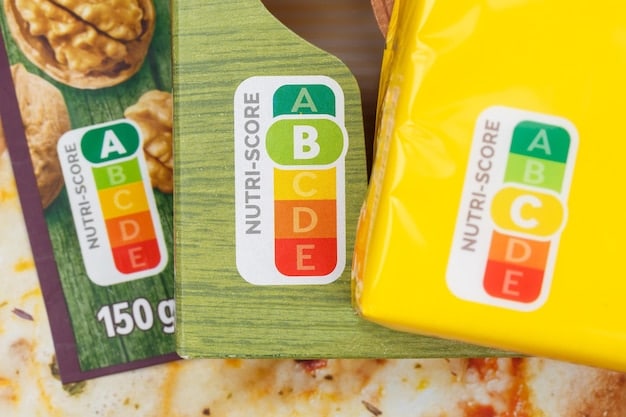Processed Foods: Understanding Risks & Latest Nutritional Studies

Understanding the Risks of Processed Foods: A Deep Dive into the Latest Nutritional Studies reveals the potential health consequences of consuming processed foods, highlighting concerns such as increased risk of obesity, heart disease, and type 2 diabetes.
Are you concerned about the impact of processed foods on your health? This article, understanding the risks of processed foods: a deep dive into the latest nutritional studies, explores the science behind processed foods and their potential impact on your well-being. Let’s delve into the world of processed foods and understand the latest nutritional research.
What Are Processed Foods?
Processed foods are defined as any food that has been altered from its natural state, involving processes like canning, freezing, drying, or fortification. These modifications are often intended to extend shelf life, enhance flavor, or improve convenience. Understanding the extent of processing is the first step in assessing potential health risks.
But what exactly separates a minimally processed food from an ultra-processed one?
Levels of Food Processing
The level of processing varies widely. It’s helpful to differentiate between minimal processing and more extensive modifications.
- Minimally Processed Foods: These retain most of their natural characteristics. Examples include pre-cut vegetables, bagged salads, and roasted nuts.
- Processed Foods: These undergo some alterations but still resemble their original form. Examples include canned fruits, cheese, and bread.
- Ultra-Processed Foods: These often contain added sugar, salt, and unhealthy fats. Examples include soft drinks, packaged snacks, and ready-to-eat meals.
The real concerns arise with ultra-processed foods due to their additives and nutritional deficiencies. Minimally processed foods can still be part of a healthy diet, but ultra-processed options should be limited.
In summary, processed foods are a wide category, and it’s important to know the differences in what that entails. Knowing the different degrees of processing can empower consumers to make informed choices.

The Link Between Processed Foods and Obesity
One of the most significant health risks associated with processed foods is their contribution to obesity. These foods are often energy-dense and nutrient-poor, leading to overconsumption. Over time, this can lead to weight gain and obesity-related complications. Obesity has become a prevalent issue in the US, and processed foods play a substantial role in the problem.
Why are these foods so linked to weight gain?
High Calorie Density
Processed foods tend to be high in calories due to added sugars, fats, and refined carbohydrates. They also tend to be less filling, causing people to eat more to feel satisfied.
Impact on Satiety
Due to their composition, processed foods often don’t trigger the same satiety signals as whole foods. This can lead to eating beyond what the body needs, contributing to weight gain.
When it comes to managing weight, focus on eating nutrient-dense foods rich in fibers. This helps feel fuller longer, so it’s easier to maintain a healthy weight. Eating a varied diet rich in whole foods can also help maintain a healthy lifestyle.
To conclude, the link between processed foods and obesity is one of significant concern, and understanding the impact these foods have on weight management is essential for maintaining a healthy lifestyle.
Cardiovascular Risks Associated with Processed Foods
Cardiovascular health is significantly impacted by the consumption of processed foods. These foods often contain high levels of sodium, saturated fats, and trans fats, all of which can negatively affect the heart. Long-term consumption can elevate the risk of heart disease, stroke, and hypertension. The prevalence of these issues in the US highlights the importance of focusing on heart-friendly diet choices.
But how do these ingredients damage the heart?
High Sodium Levels
Excessive sodium intake raises blood pressure, increasing the strain on the heart and blood vessels. Processed foods are a major source of added sodium in many diets.
Saturated and Trans Fats
These fats can raise LDL (bad) cholesterol levels, leading to plaque buildup in the arteries. Many processed foods are loaded with these unhealthy fats to enhance taste and texture.
The Role of Additives
Certain additives in processed foods have also been linked to cardiovascular risks. Phosphates, for example, can negatively impact blood vessel function.
To mitigate these risks, it’s beneficial to limit intake of processed foods. Focusing on whole, unprocessed foods naturally low in sodium and saturated fats supports a healthy heart. Preparing homemade meals using fresh ingredients is one way to dodge excessive sodium and unhealthy fats found in processed foods.
In summary, the cardiovascular risks associated with processed foods are driven by their high levels of sodium, saturated fats, and harmful additives. Mindful dietary choices can safeguard heart health.
Processed Foods and the Risk of Type 2 Diabetes
Type 2 diabetes is a growing health concern, and processed foods play a significant role in its development. These foods are often high in refined carbohydrates and added sugars, which can lead to insulin resistance and elevated blood sugar levels. Understanding the link between processed foods and diabetes is important for prevention.
How do processed foods contribute to diabetes?
Refined Carbohydrates
Processed grains like white bread and pastries cause rapid spikes in blood sugar, straining the pancreas. Consuming these refined carbs consistently can lead to insulin resistance.
Added Sugars
High amounts of added sugars—especially in beverages like sodas—contribute to weight gain and insulin resistance. These sugars add empty calories that increase the risk of diabetes.

Lack of Fiber
Fiber helps regulate blood sugar levels and promote satiety. Processed foods are typically low in fiber, exacerbating blood sugar control issues.
To reduce the risk of type 2 diabetes, limit processed foods high in refined carbs and added sugars. Eat foods rich in fiber, like whole grains, fruits, and vegetables, to stabilize blood sugar levels. Regular exercise and maintaining a healthy weight can also significantly lower the risk of type 2 diabetes.
In essence, controlling the consumption of refined carbs, added sugars, and incorporating high-fiber foods is essential for averting type 2 diabetes. Understanding how processed foods affect blood sugar levels empowers healthier lifestyle choices.
The Impact of Additives and Preservatives
Processed foods contain numerous additives and preservatives designed to enhance flavor, texture, and shelf life. While many of these substances are deemed safe by regulatory bodies, some raise concerns about potential health effects. It’s vital to understand what these additives are and how they might impact your health.
What should you know about these additives?
Common Additives and Their Purpose
Additives such as artificial sweeteners, artificial colors, and flavor enhancers like monosodium glutamate (MSG) are widely used in processed foods. Preservatives like sodium benzoate and sulfites prevent spoilage and extend shelf life.
Potential Health Effects
- Artificial Sweeteners: Some studies suggest that artificial sweeteners may disrupt gut bacteria and increase the risk of metabolic disorders.
- Artificial Colors: Certain artificial colors have been linked to hyperactivity in children and allergic reactions in sensitive individuals.
- Flavor Enhancers: MSG has been associated with headaches, nausea, and other adverse effects in some people.
To mitigate potential risks, read food labels carefully and opt for foods with fewer additives. Choosing whole, unprocessed foods minimizes exposure to artificial substances. Be vigilant and report any adverse reactions if you believe an additive is affecting your health.
In conclusion, being mindful of food additives and preservatives by carefully monitoring food labels can significantly reduce exposure. Awareness empowers individuals to make informed choices that support long-term health, ensuring a diet that minimizes these potential risks.
Strategies for Reducing Processed Food Consumption
Reducing processed food consumption can significantly improve overall health. It requires awareness, planning, and a shift in dietary habits. Here are some strategies to help you minimize your intake of processed foods and adopt a healthier lifestyle.
How can you start today?
Read Food Labels
Get familiar with reading nutrition labels to identify hidden sugars, fats, and additives. Look for shorter ingredient lists with recognizable ingredients.
Plan Your Meals
- Prepare a Weekly Menu: Planning your meals in advance helps avoid last-minute decisions that lead to processed food choices.
- Cook at Home: Cooking at home allows you to control ingredients and portion sizes, reducing your reliance on processed options.
- Batch Cooking: Prepare larger quantities of healthy dishes on weekends to have ready-made meals for the week.
Shop Smart
Focus on buying whole, unprocessed foods like fruits, vegetables, lean proteins, and whole grains. Shop the perimeter of the grocery store, where these items are typically located.
By consistently implementing these strategies, you can reduce your consumption of processed foods. Small changes can lead to big improvements in your health, enhancing overall well-being.
To recap, by being diligent about reading food labels, meal planning, and smart shopping, reducing dependence on processed foods is an attainable and a positive step towards a healthier diet.
Navigating the Grocery Store: A Guide to Healthy Choices
The grocery store can be a minefield of processed foods, but it’s also where you can find everything you need for a healthy diet. Knowing how to navigate the aisles effectively is key to making better choices. Focus on strategies for making healthy decisions in this environment.
What should you consider while you shop?
Shop the Perimeter
Most grocery stores place fresh produce, meat, dairy, and other minimally processed items around the outer edges. Focus your attention on these sections. For everything else, tread carefully.
Beware of Aisle Traps
The inner aisles often feature processed snacks, sugary drinks, and packaged meals. These tend to be high in calories and low in nutrients. Limit your time in these aisles.
Learn to Spot Clever Marketing
Food manufacturers use appealing packaging and health claims to sell processed foods. Don’t be fooled by these tactics. Always check the nutrition label and ingredient list.
By adopting these strategies, you can navigate the grocery store with confidence and make healthier choices. Shopping intentionally and cautiously can make a tremendous difference in your diet.
In summary, approaching the grocery store with mindfulness helps you to make healthier decisions. Armed with knowledge about what to find on the perimeter and what to avoid in the inner aisles ensures a grocery trip will support a healthier lifestyle.
| Key Point | Brief Description |
|---|---|
| ⚠️ Processed Foods | Foods altered from their natural state via canning, freezing, or adding preservatives. |
| ❤️ Cardiovascular Risks | High sodium, saturated fats, and trans fats increase heart disease risk. |
| 🍎 Fiber | Lack of fiber in processed foods can cause blood sugar issues. |
| 🛒 Shopping Tips | Focus on the perimeter for fresher ingredients and read nutrition labels. |
FAQ Section
▼
The main risks include increased rates of obesity, cardiovascular concerns due to high sodium and fats, and a higher risk of type 2 diabetes due to added sugars. Also, there is the potential impact of additives on overall health.
▼
Check the ingredient list for long, unrecognizable names and look for high levels of sodium, sugar, and unhealthy fats. Shopping the store perimeter where fresh products are usually placed can also help avoid processed foods.
▼
No, some processed foods like pre-cut vegetables or canned beans are minimally processed and can be part of a healthy diet. It’s the ultra-processed foods high in sugars, fats, and additives that you should be wary of.
▼
Planning meals ahead, cooking at home, and reading food labels are all great strategies. Focus on buying whole foods and limit your time in store aisles filled with processed snacks and meals.
▼
Some additives have been linked to adverse health effects such as hyperactivity, metabolic issues, and allergic reactions. Reading labels and opting for fewer additives can minimize exposure and protect your health.
Conclusion
In conclusion, **understanding the risks of processed foods: a deep dive into the latest nutritional studies** highlights the importance of making informed dietary choices for overall health. By focusing on whole foods, reducing processed intake, and being aware of additives, people can mitigate potential health risks and improve their well-being.





